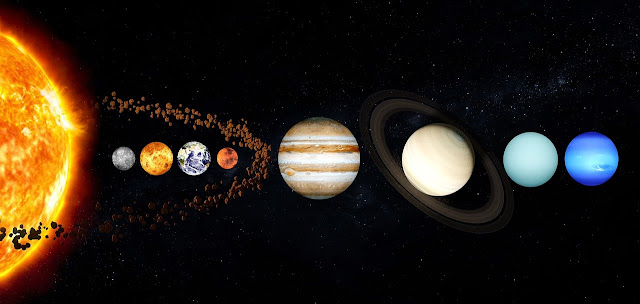Why is Neptune blue? - Due to the composition of its atmosphere, Neptune appears blue, although there is no liquid water on its surface. Therefore its name “Neptune”, god of the sea in Roman mythology, is misleading.
Methane in the atmosphere gives Neptune its color.
Neptune is almost four times the size of the earth, and has an extensive atmosphere consisting primarily of hydrogen and helium. At the low temperatures at the visible upper cloud limit of minus 215 degrees, methane freezes, creating haze particles. That is why the planet appears blue.
Neptune is the furthest planet from the Sun in our solar system. While the earth orbits the sun in 365 days, it takes Neptune 165 years. Neptune has a diameter of 49.528 kilometers and although is much bigger, it rotates faster on its own axis than the earth: in 16 hours and 7 minutes instead of 24 hours.
When was Neptune discovered?
Neptune was the first planet discovered through mathematical calculations. In 1846, John Couch Adams (5 June 1819 – 21 January 1892), a British mathematician and astronomer, determined the position of Neptune using only mathematics.
Around the same time, the French astronomer Urbain Le Verrier (11 March 1811 – 23 September 1877) calculated the position of the planet independently of Adams.
Le Verrier shared his findings with the German astronomer Johann Gottfried Galle (9 June 1812 – 10 July 1910), who identified Neptune in the Berlin observatory on September 23, 1846 and increased the number of known planets to eight.
Voyager 2's flyby in 1986 and 1989 has been the only visit by a space probe to date.
How far is Neptune from the Earth?
As Neptune and Earth move through space, the distance between them changes constantly. When the planets are closest together, they are 4.3 billion km away. Neptune is 4.7 billion kilometers from Earth. Due to its extreme distance from our planet, Neptune became the last planet in the solar system to be discovered.
Neptune is the windiest planet in the solar system: the winds reach speeds of around 2,100 km / h. Because Neptune is a great distance from the Sun, its outer atmosphere is one of the coldest places in the solar system.
Neptune's moons
Neptune fits into the rank of the gas planets, surrounded by rings and has 14 moons named for minor water deities in Greek mythology. By far the most interesting is the Neptune moon Triton, with a diameter of 2760 kilometers. It is smaller than the Earth's moon, but shows a variety of surface structures. Other confirmed moons on Neptune are: Naiad, Thalassa, Despina, Galatea, Larissa, Hippocamp, Proteus, Nereid, Halimede, Sao, Laomedeia, Psamathe, Neso
Neptune's rings
Neptune has five main rings named after the astronomers who studied this blue planet. They were discovered in 1984 and finally captured by Voyager 2 in 1989.












